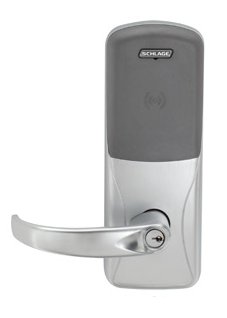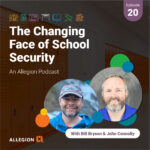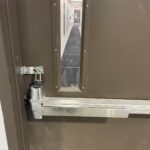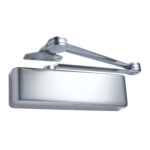I really enjoyed reading everyone’s input on my post about emergency exit seals, and since I’m currently in a 3-day class for the NFPA Certified Fire Plan Examiner program and don’t have a lot of time for blogging, here’s another question for which I have no concrete answer but would love your insight…
The national accessibility standards don’t directly address keys. I have been told that this is because keys are not a permanent part of a door opening. But my theory is that keys are not addressed because they’re an accessibility problem that is not easy to overcome, due to the hundreds of millions of existing locks with keys and the comparable cost of an electrified replacement. It may be feasible to replace a lock here and there, but when you consider the issue of keyed locks as a whole, removal of this barrier is not “readily achievable.”
Keys require tight grasping, tight pinching, and twisting of the wrist – all actions that are not allowed by the accessibility standards for the operation of door hardware. While it’s true that the actual key is not a permanent part of the door hardware, the bottom line is that hardware which requires a key for access is difficult or impossible for people with certain types of disabilities to operate.
I recently talked to a code official about this, with regard to accessible units of multi-family housing in his jurisdiction. His preference was for all of the accessible units (typically a small percentage of the total units) to have electrified locks with proximity readers. In his opinion, locks which required keys, a keypad/code, or the insertion of a card, should not be used on dwelling units that were required to be accessible. Although the national standards do not yet require electrified locks with proximity readers, I have heard the same preferences from other AHJs. Some questions for you to ponder (and comment on!)…
- Have you seen a preference for electrified locks with proximity readers on accessible units in your jurisdiction?
- Has a facility asked you for help to retrofit existing locks for a new building occupant who was unable to operate keyed locks?
- Should proximity readers replace key-operated locks in locations beyond accessible multi-family dwelling units?
- Is there another type of lock credential that you would consider accessible?
- If you were proposing a change to the national accessibility standards, what would that proposal look like?
Now, talk amongst yourselves while I study. 🙂
You need to login or register to bookmark/favorite this content.






In my little world one accomodation we make is to use classroom function locks on offices where turning a key to pull back the latch is difficult.
If a department wants some type of electronic locking, the department must pay for it.
Med rooms and any area with controlled substances get some version of electronics.
Many do pony-up for keypads on conference,locker and staff lounge rooms.
It seems to me that the existing language prohibiting tight grasping and twisting of the wrist already eliminates keys as a method of operating door hardware on accessible openings. Imagine a person with a physical or visual impairment attempting to manipulate a key, versus using a prox card.
I think the AHJ referenced above has the right perspective, and this is a matter of enforcing the language that exists in ADA and ANSI A117.1, as opposed to writing new requirements.
I’m mostly institutional,but the standalone proxreader lock definitly fills the bill for those applications.
I am using more of these, but for security, not accessibility.
I don’t think we need more standards that would require prox locks on all accessible housing units. What would be reasonable would be an assement by the building owner that some occupants will need this type of access and be willing to provide it.
Even though there are large bow keys called “Handicap Bow” by some manufacturers, I agree with Kurt in that the dexterity required to insert and turn a key; retract a latch and open the door; then return the key to the starting position and remove the key doesn’t seem to jibe with the accessibility standards.
I think a prox reader certainly fits the bill.
We do see key fobs on market-rate multi-family pretty often here, and we have proximity readers all over tenant improvement work with nearly no other locks.
There are interesting retrofit electronic replacements for key-operated deadbolts coming along, like Goji (http://www.cepro.com/article/is_goji_the_smartest_deadbolt_lock_ever/) and Lockitron (https://lockitron.com/) and August (http://www.august.com/), my techie husband’s favorite. With the proliferation of these devices, it’s becoming harder to claim that you can’t accommodate someone whose hands can’t manage keys. The flip side of this is the electronic security required: the facility is then (with some of the devices) only as secure as the wireless network or the password. The expertise required to secure the retrofit locks will easily cost more than the locks themselves, if the owner is naive about electronic security. And they really won’t work on doors that require a single operation to exit, since they are designed for separate deadbolts. The specifying community does need to understand these devices, since they’re becoming available quickly and look like alternatives to “real” security systems. If I were retrofitting one apartment for a tenant in need, I might be willing to try such a thing, but they’re no solution for a business as far as I can tell.
Good luck with your studies, Lori!
I’ve pondered this one (amongst other ponderings) before, and basically decided to wait-and-see, rather than stir up a controversy — easily done out here on the Left Coast. My thinking for now is that we can readily make accommodations as requested, but I don’t know that the market is ready to pay for near-effortless operation as the norm.
I question how the electronic deadbolts shown by Vivian meet ADA any better than a key! They still require a gripping/twisting motion.
Electromagnetic locks in conjunction with door operators – controlled by proximity readers and PIRs